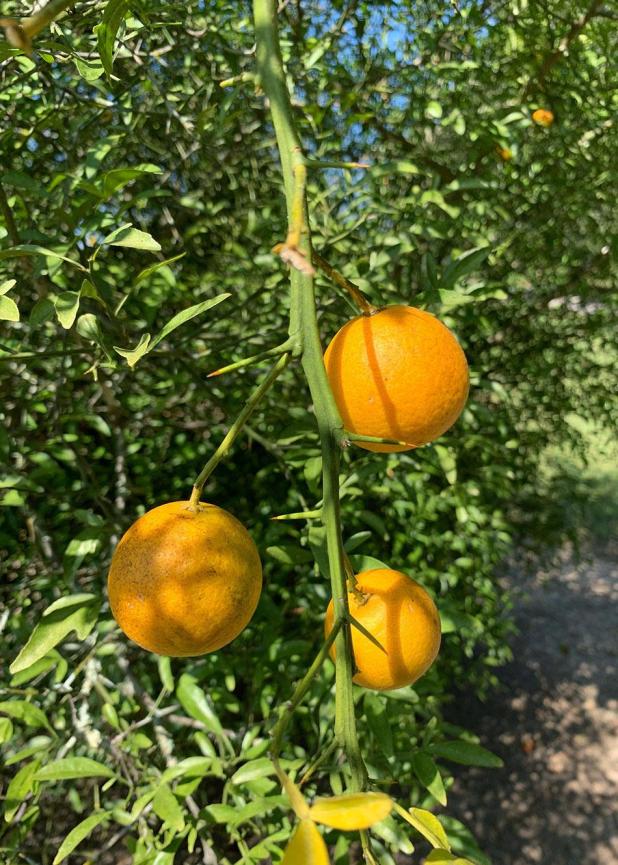
This trifoliate orange sucker has grown so large it produced fruit and large thorns. Remove suckers like this to conserve energy for fruit production of the desired tree.
—LSU AgCenter/Anna Ribbeck
Get It Growing: A chat about Citrus
Citrus holds year-round interest in the garden and landscape. For starters, citrus are evergreen trees and shrubs native to subtropical and tropical regions of Asia. They originated at the foothills of the Himalayan mountains from trifoliate citrus (Citrus trifoliate).
Citrus trees generally are only winter-hardy in USDA plant hardiness zones 9a through 11. In the remainder of the hardiness zones, citrus must be grown in a greenhouse or brought indoors during cold months when there is a threat of frost. The southern portion of Louisiana is in zones 9a and 9b, while the northern portion falls into zones 8a and 8b.
Fun fact: An orangery or orangerie is as a room or dedicated building where oranges and other tropical fruit trees are protected during the winter. These were often large greenhouses or conservatories found on the grounds of wealthy residences from the 17th to the 19th centuries. You can visit the orangerie at the LSU AgCenter Botanic Gardens at Burden in Baton Rouge to get an idea of what one looks like.
There are many types of citrus from citron, clementine, grapefruit, lemon, lime, mandarin orange, sweet orange, kumquat, tangerines and pomelos to the most prominent in Louisiana, the satsuma — and many more.
Citrus are active year-round. They do not go dormant in wintertime, but they do slow their growth. Most citrus will go into active growth in late winter and early spring, followed by flower production that gives way to fruit in the fall and winter for most citrus varieties.
Growth typically occurs in three flushes with the first in late February and March. This is usually the time of the greatest shoot extension because more buds elongate. The second flush occurs in August, and the last takes place in October. During growth flushes, the shoots elongate in between the flushes, the leaves expand to full size and root growth occurs.
One question I often get from home citrus growers are about the sprouts shooting up from the bottom of trees that bear large, sharp thorns. Let us recall that citrus originated from a single type called trifoliate citrus at the foothills of the Himalayas. The trifoliate orange, Citrus trifoliata, has also been called Poncirus trifoliate, and this has been a debated subject.
Trifoliate orange was historically a member of the genus Citrus until Walter Swingle moved it to its own genus, Poncirus. This was mainly because unlike other citrus, trifoliate is deciduous and has thorns, compound leaves and green, fuzzy, bitter fruit with many seeds.
What does this have to do with thorns on your satsumas? Well, trifoliate orange, also known as hardy orange, is cold-hardy to USDA zone 6, allowing it to tolerate lower temperatures, moderate frosts and light snow. Because of this cold hardiness, many other citrus fruit trees are grafted onto the trifoliate rootstocks.
Defined in general terms, the process of grafting takes the roots of one plant, called the rootstock, and joins it to the shoots of another plant, called the scion. The tops are chosen for their fruit quality, and the rootstock is chosen for its cold tolerance, disease and pest resistance.
Citrus trees are grafted for two main reasons. First, the rootstock is more cold hardy, and second, seedlings can take up to 15 years to produce fruit, but those grafted can produce much sooner.
The citrus trees you purchase have all been grafted onto a different rootstock, usually trifoliata orange Rubidoux or Swingle citrumello. Trifoliata rootstock is prized for its phytophthora disease resistance, nematode resistance, standing water tolerance and compact size that produces tasty fruit.
Some growers have begun grafting onto a dwarf rootstock of trifoliata called Flying Dragon. As a rootstock, it causes dwarfing of the scion and produces smaller, even tastier fruit than Rubidoux. Flying Dragon is more resistant to blight disease and tolerant of most viruses, and dwarf trees are great for homeowners with smaller spaces.
When you notice suckers coming up from the root portion of the tree or from underneath the point of where the graft was made, you should remove these shoots, or “suckers.” The graft union is easily distinguished on smaller trees as a swollen point or discolored point on the trunk an inch or more above the soil line. It can often cause a crook or curve in the trunk at the point of the graft union.
We remove these suckers not only because of the thorns, but because the tree will put wasted energy into a portion of the plant that is not intended to grow branches, and the suckers could produce poor quality, seedy, bitter fruit. When you see suckers below the graft union, remove them with a hand pruner all the way back to the trunk. Check for rootstock suckers often, and as soon as you notice one, snap it off or cut it off close to the trunk or ground to keep your citrus productive.
